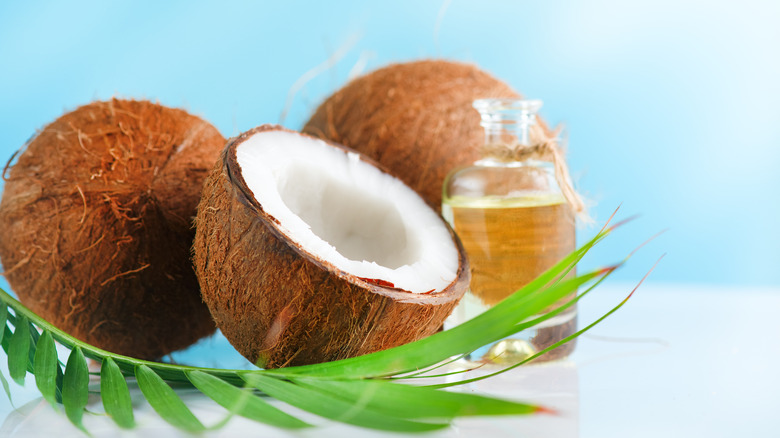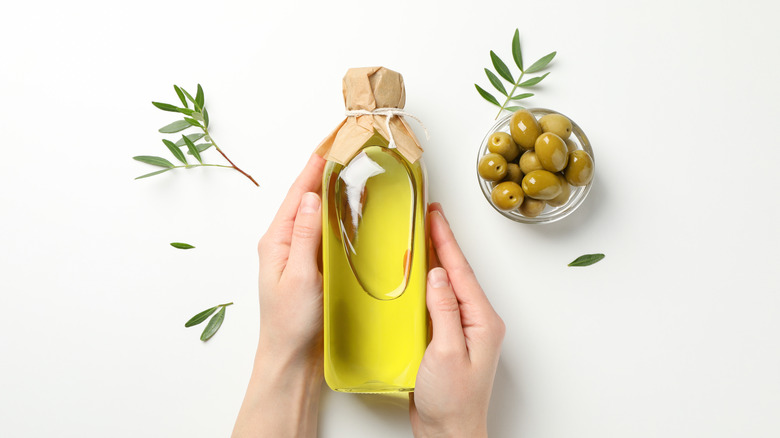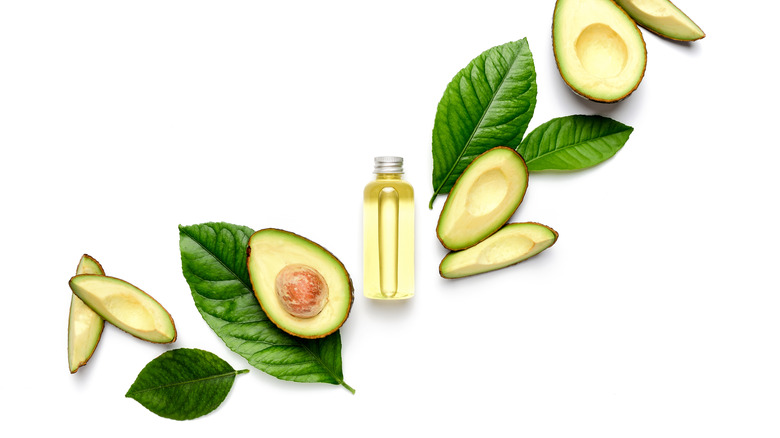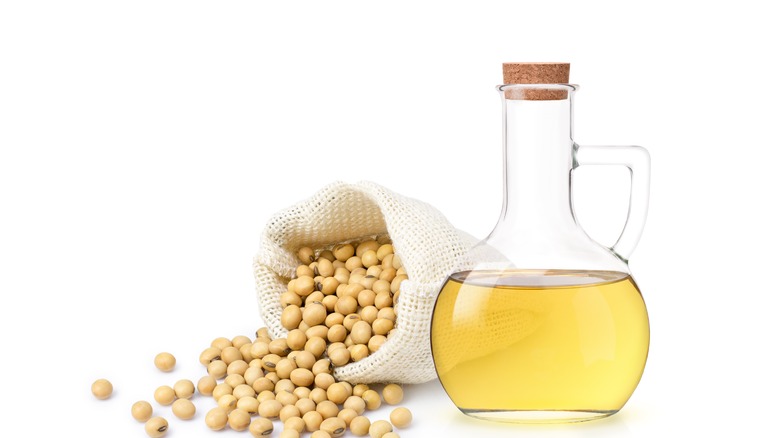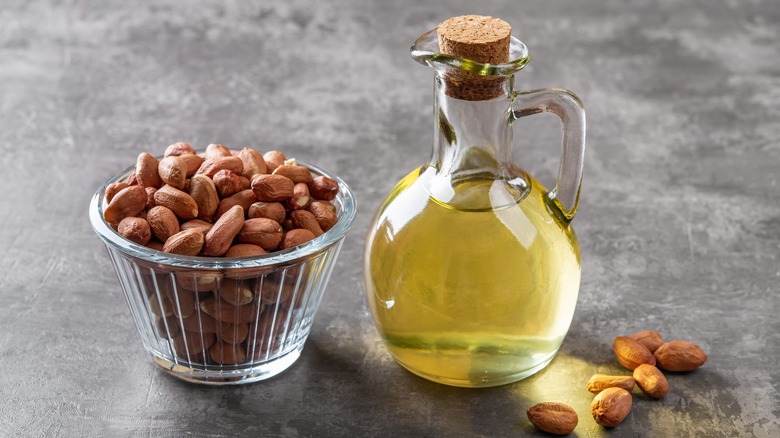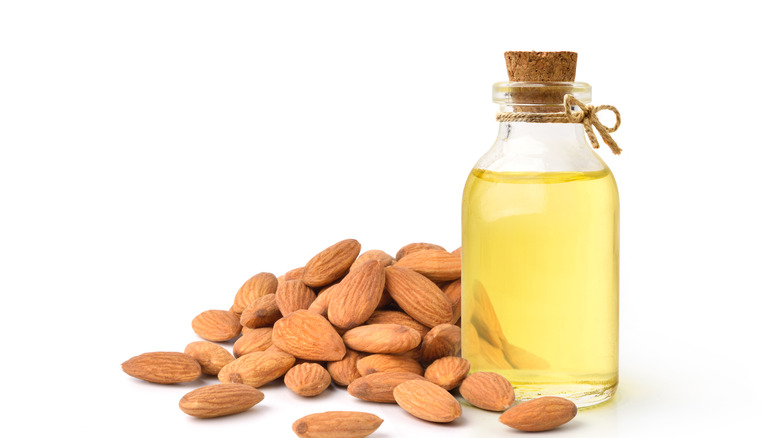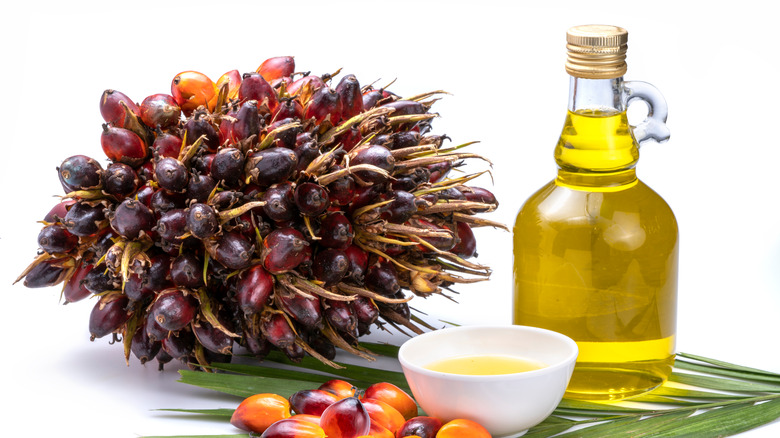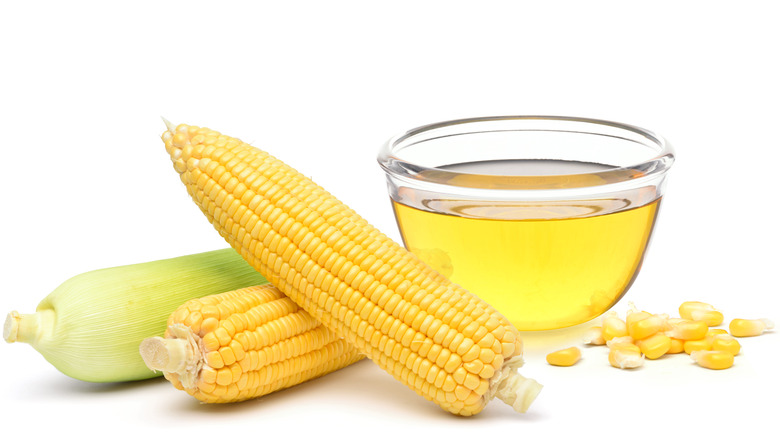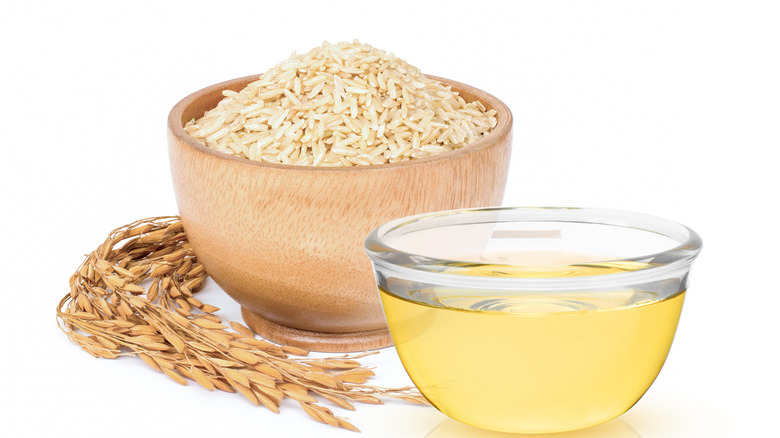The 9 Best Oils For Deep Frying
Deep-frying is an old yet popular cooking method that involves immersing food in hot oil, typically at very high temperatures that range between 302 and 374 degrees Fahrenheit. This results in foods with a unique and desirable flavor, golden color, and crisp texture, as a study published in the Journal of Food Science explains.
However, not every oil produces the same results when it comes to deep-frying, and heating some oils can even lead to the production of chemical compounds that may be harmful to your health. To achieve the best results, it's important to use an oil with a high smoke point and a neutral flavor. The smoke point of an oil is the temperature at which an oil starts to smoke, meaning that its chemical profile begins to change due to continuous heat exposure (via Michelin Guide). Aside from producing harmful compounds, another unwanted change made by heating an oil past its smoke point is a rancid or bitter flavor, which you certainly want to avoid.
In addition to an oil's smoke point, its fatty acid composition can also be a factor in its suitability for deep-frying. As noted by a study published in the Research Journal of Applied Sciences, the best oils for deep-frying should have a high level of monounsaturated fatty acids, moderate amounts of saturated fatty acids, and a low level of polyunsaturated fatty acids, which ensures better heat stability. Keep reading to find out more about the nine best oils for deep-frying!
1. Virgin coconut oil
Virgin coconut oil is an oil that is extracted from the meat of fresh coconuts without the use of heat or chemicals. It is considered to be unrefined and has a more natural, coconutty flavor than refined coconut oil, as well as a higher content of biologically active compounds, according to a study published in the Journal of Food Science and Technology. While its popularity has skyrocketed over the years as a personal care and beauty product due to its numerous potential health benefits, virgin coconut oil's nutritional profile also makes it an excellent oil for deep-frying.
Virgin coconut oil is high in saturated fats, which gives it a high smoke point of 376 degrees Fahrenheit (per a study published in Acta Scientific Nutritional Health). This means that it is relatively stable at high temperatures and makes it well-suited for deep-frying. In addition, it has a long shelf life, which is an added bonus. However, keep in mind that deep-frying with virgin coconut oil will give your food a coconutty flavor, which can be both a pro and a con, depending on what you're cooking. For instance, using virgin coconut oil to deep-fry is perfect for Caribbean dishes that call for deep-fried chicken, fish, or shrimp.
2. Olive oil
Olive oil is touted as one of the healthiest oils out there, yet, aside from providing numerous health benefits, it is also highly versatile as well as delicious. Olive oil is made from the fruit of the olive tree, which is native to Mediterranean regions. The process of making olive oil involves harvesting the olives, then washing, crushing, and separating the oil from the water and solids. However, different processing methods yield different types of olive oils, such as regular, virgin, or extra virgin varieties. When it comes to regular olive oil, it is produced by mixing extra virgin olive oil and refined olive oil (via U.S. News & World Report).
Despite having what's considered a moderately high smoke point of 390 to 468 degrees Fahrenheit, regular olive oil is a healthy choice for cooking due to its high monounsaturated fat content. According to a study published in Food and Chemistry Toxicology, this makes olive oil resistant to heat or frying conditions. Plus, it has a lighter color and milder flavor compared to the virgin and extra virgin varieties, so its taste doesn't have a strong aroma, making it great for deep-frying just about anything — or cooking in general.
3. Avocado oil
Avocado oil is a heart-healthy oil that has gained a lot of popularity in recent years. According to a 2021 study published in Foods, it went from being primarily used as a dressing or seasoning to being an alternate oil for cooking. Avocado oil is made from the flesh of the avocado fruit. The process of making avocado oil involves removing the skin and pit from the avocado, then pureeing the flesh and extracting the oil — a process similar to that of olive oil.
Like olive oil, avocado oil is rich in monounsaturated fatty acids, a nutritional quality that grants it plenty of heat stability. However, with its high smoke point of 520 degrees Fahrenheit, this oil has the highest smoke point among common cooking oils (via Michelin Guide), making it suitable for high-heat cooking methods such as sautéing, grilling, and deep-frying. In terms of flavor, avocado oil is mild, buttery, and nutty, a taste that is very similar to avocados themselves, and it doesn't have a strong aftertaste. Plus, according to the aforementioned study, using avocado oil for deep-frying may help transfer its heart-healthy compounds into your food.
4. Soybean oil
Soybean oil is one of the most widely used oils in the United States. In fact, between 2021 and 2022, about 13 million tons of soybean oil were produced in the U.S. (per The Soybean Processors Association of India). It is also relatively inexpensive, which is why it is a commonly used oil in processed foods. Soybean oil is made from the seeds of the soybean plant. The process of making soybean oil typically involves cleaning and dehulling the soybeans, then using a mechanical or solvent-based method to extract the oil. While the latter is a more efficient method, it can leave a strong, undesirable flavor. In contrast, the mechanical technique produces an oil that has a mild and neutral flavor, making it suitable for use as a cooking oil (via Oil Mill Machinery).
Soybean oil has a high smoke point of around 450 degrees Fahrenheit, so you can use it for high-heat cooking methods like frying and sautéing (per Healthline). Furthermore, according to a study published in the Research Journal of Applied Sciences, it also has a good nutritional profile with a high level of unsaturated fatty acids (the healthy kind). Yet, as Healthline explains, it also has a high amount of omega-6 fatty acids, which is associated with poor health outcomes.
5. Peanut oil
Peanut oil is the perfect oil to cover all your frying needs. It is an edible vegetable oil that is made by grinding peanuts and then extracting their oil. It is lighter in color compared to other traditional cooking oils and has a sweet and nutty yet predominantly neutral flavor that goes well with most foods. Furthermore, you can even use it interchangeably with other cooking oils (but it should be heated to higher temperatures than olive oil when cooking).
In addition, with a high smoke point of 450 degrees Fahrenheit, it is ideal for a number of high-heat cooking techniques without the risk of burning or over-browning food. In fact, according to a study published in the Journal of Food Science and Technology, peanut oil is also rich in monounsaturated fatty acids, which makes it adequate for prolonged frying. Peanut oil's main culinary uses are deep-frying and sautéing meat products and preparing stir-fry recipes, common in Asian home cooking. Nevertheless, this oil comes with one caveat: While research is still inconclusive, it may not be a suitable choice for people with peanut allergies (via WebMD).
6. Almond oil
While it gained popularity for boosting skin and hair health, almond oil also comes with culinary advantages. Almond oil is produced from almonds and has a rich, nutty flavor that works well in savory dishes. However, not all almond oils are suited for deep-frying, and it all comes down to their processing method. There are two types of almond oil: refined and unrefined, and while unrefined almond oil is made by cold press extraction to ensure that the flavor and nutrients are retained, the processing required to create refined almond oil grants it a higher heat tolerance — meaning that this is the one you should use for deep-frying purposes (via Healthline).
Refined almond oil has a smoke point of about 420 degrees Fahrenheit, making it ideal for frying at low temperatures. It works well with all kinds of fish but can be used like any other neutral-flavored oil, and it complements mildly flavored foods like eggs and rice. Plus, by adding almond oil to your diet, you may also reap its numerous health benefits, which may boost your immune, heart, and skin health, per a study published in the journal Complementary Therapies in Clinical Practice.
7. Palm oil
Palm oil is the most used oil worldwide, seeing that it is needed for countless different products ranging from cosmetics to pet food, cleaning supplies, and, of course, your favorite foods (via Conservation International). It is extracted from the fruit of the oil palm tree through a process that involves removing the fruit from the tree and then sterilizing it by steaming it. Then, the fruit is pressed to extract the oil, which can be further refined to remove impurities (per Oil Refinery Plant).
Like all the other vegetable oils from this list, palm oil is an excellent choice for deep-frying because of its high smoke point, around 450 degrees Fahrenheit (via Asia Palm Oil Magazine). In fact, a study published in Antioxidants determined that there were few changes in palm oil's antioxidant properties between the first and the 20th frying cycle, meaning that it has a great stability to high heat. In addition, you can also use it in any dish that calls for butter or vegetable oil. While some describe its taste as buttery, refined palm oil is generally considered a neutral and odorless choice that won't overpower your dishes, making it suitable for a wide range of uses.
However, it's important to consider that unsustainably sourced palm oil is highly detrimental to the environment and wildlife. Thus, be sure to go for one that comes from sustainable sources, which can be identified by a label on the oil's packaging, as Conservation International explains.
8. Corn oil
Corn oil (or maize oil) is a popular oil used in the United States not only for culinary purposes but for many industrial processes as well. In fact, the U.S. is the largest corn oil producer worldwide. With an average production of around 2 million tons per year, it's responsible for over 50% of the world's corn oil supply (per Atlas Big). Corn oil is extracted from the germ of the corn kernel. The process of extracting corn oil typically involves mechanically pressing or using chemical solvents to remove the oil from the germ. After the oil is extracted, it is refined, which removes impurities and improves the flavor and color of the oil. In addition, the refining process is what allows it to withstand high cooking temperatures (via ABC Machinery).
Speaking of flavor, this oil has a neutral and pleasant taste with a hint of sweetness and only a mild aroma, making it an excellent choice for cooking pretty much anything. Plus, its characteristically high smoke point of around 450 degrees Fahrenheit makes it ideal for deep-frying all kinds of foods, from fried chicken or seafood to fries or vegetables. However, while it is a perfect choice for deep-frying that may even provide a couple of health benefits, corn oil is also high in omega-6 fatty acids, which can promote inflammation. Thus, it would be best to consume it in moderation (via Healthline).
9. Rice bran oil
A well-known oil in countries like India, Japan, China, Thailand, and Vietnam, rice bran oil has gained popularity due to its numerous potential health benefits, in addition to being a deep-frying-friendly oil. Rice bran oil is extracted from the outer layer of the rice kernel, known as the bran, and, according to a review published in the Journal of Oleo Science, it has a fatty acid composition that falls very close to recommendations by the American Heart Association (AHA) and World Health Organization (WHO) for edible oils in terms of heart health. Furthermore, a study published in the Journal of Food Science and Technology explains that the oil contains a compound called oryzanol, which is believed to increase good cholesterol levels while lowering bad cholesterol and triglyceride levels.
Rice bran oil has a smoke point of 490 degrees Fahrenheit (via MasterClass), as well as a high oxidative stability, which is why it is a suitable option for high-heat cooking methods like frying, deep-frying, and sautéing. When it comes to flavor, it has a mild yet slightly nutty taste that resembles that of peanut oil, making it ideal for preparing Asian fried dishes like tempura fish, meat, and vegetables.

